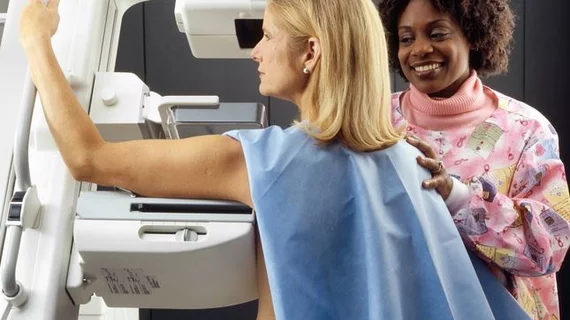Yes, mammograms could screen women for CVD—but not yet
Women with breast arterial calcifications (BACs) are at an increased risk of cardiovascular disease (CVD). According to a new analysis published in the European Journal of Radiology, this opens the door for mammograms to screen patients for both breast cancer and CVD at once.
“BAC are easily recognizable on routine mammograms that women periodically undergo spontaneously or through organized population-based programs for breast cancer screening from 40, 45 or 50 years of age, according to different national or local policies,” wrote Rubina Manuela Trimboli, Università degli Studi di Milano in Milan, Italy, and colleagues. “Thus, there is a strong rationale for mammography to serve as a preventive test beyond breast cancer screening, spotlighting on the heart and more comprehensively on CVD risk.”
Prior research had found that a higher BAC prevalence is associated with increasing age, diabetes and a prior pregnancy. Smoking, meanwhile, was associated with a lower BAC prevalence. No associations between BAC prevalence and hypertension, obesity or dyslipidemia were observed.
Also, the authors added, BAC prevalence is much higher in menopausal women, and hormonal therapy is associated with a much lower prevalence of BAC. And women with BAC are more likely to develop heart disease or a stroke, even after adjusting for age.
“Thus, identifying and consistently reporting BAC presence and severity on mammography is paramount at all ages, in particular in women under 65, where traditional risk factors may not be so prevalent due to the later onset of CV events in women and actual CVD risk may be underestimated,” the authors wrote. “BAC are not only an imaging biomarker for CVD risk, but represent a predictive factor for CVD events.”
The authors emphasized, however, that there is still plenty of work to be done before mammography can be used in clinical practice as a reliable tool for screening patients for CVD.
When BACs are detected presently, for instance, they are reported as being “present,” but no further action is taken. BACs set off no “alarms” that an issue may be at hand. Also, the authors added, it can be challenging to assess a patient’s BAC once it is detected.
“Various appearance patterns (bright tubular, single or parallel linear structures, or sporadic bright spots), topological complexity, and vessels overlap on two-dimensional projections make both identification and quantification of BAC difficult to standardize,” the authors wrote.
Currently, researchers are working with deep learning technology to see if AI can provide specialists with the necessary tools needed to use mammography for screening CVD. While some studies have shown promising results, the authors wrote, “further large scale studies are needed.”
“We need high-quality research for this, the first step being to make a reliable and user-friendly BAC quantification tools available,” the team concluded. “Preventive campaigns usually require huge efforts, both social and economic, to be implemented. In a historical phase of great attention to the healthcare expenditure, to work in favor of using BACs for CVD prevention in women, using the infrastructure of an already existing screening, implies that important results could be obtained with relatively limited costs.”

